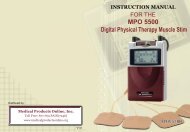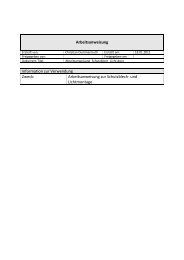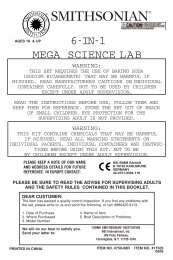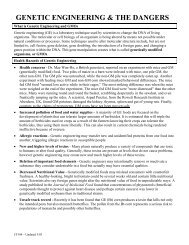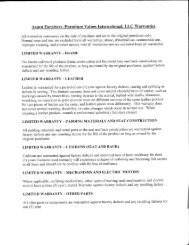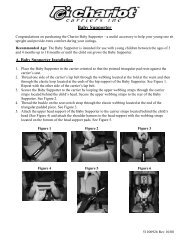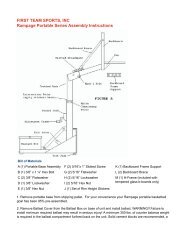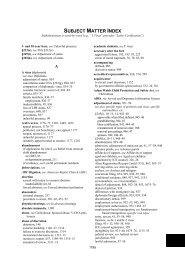You also want an ePaper? Increase the reach of your titles
YUMPU automatically turns print PDFs into web optimized ePapers that Google loves.
American abstraction’s finest<br />
living exponent<br />
14 artBooK | D.a.p. 1.800.338.2665<br />
Frank Stella<br />
hATJe CAnTz<br />
Text by holger bröker, Markus brüderlin,<br />
Gregor stemmrich, et al.<br />
Frank Stella is abstraction’s greatest living<br />
champion—the artist who, more than any other,<br />
has merged abstract painting with sculpture<br />
and architecture, pursuing the implications of<br />
his “what you see is what you see” stance. a<br />
forceful clarity of purpose and vision has characterized<br />
his art and his career from the start:<br />
he dominated the new York art scene of the<br />
late 1950s with his Black Paintings composed<br />
of stripes, which famously helped pave the way<br />
for minimalism, and which were exhibited in<br />
the museum of modern art, new York’s milestone<br />
exhibition Sixteen Americans, alongside<br />
Johns and rauschenberg. In 1970 Stella became<br />
the youngest artist to receive a show at<br />
the museum of modern art, by which time he<br />
had already blazed his way through several stylistic<br />
evolutions. to the surprise of many, the<br />
passionate race-car driver did not follow the<br />
seemingly inevitable route towards minimalism,<br />
and instead followed a path that led him to<br />
ever more opulent and baroque reliefs. With<br />
this idiosyncratic turn “from minimalist to<br />
maximalist,” Stella developed into one of the<br />
boldest artists of the twentieth century.<br />
on the occasion of Stella’s comprehensive retrospective<br />
at the Kunstmuseum Wolfsburg, this<br />
massive survey celebrates the many lives of<br />
Frank Stella. It includes classic examples of<br />
each of his many periods, such as the Black<br />
Paintings, Irregular Polygons, the Protractor<br />
paintings, the Circuits series, the metal reliefs<br />
and floor sculptures of the past two decades<br />
and an “archiSkulptur” conceived by the artist<br />
exclusively for the exhibition. With more<br />
than 660 color reproductions, this volume is as<br />
ambitious and spectacular as its subject.<br />
Frank Stella was born in 1936, to first-generation<br />
Sicilians, and grew up in a suburb of Boston.<br />
In 1954 he entered princeton University, where<br />
he took a night class in painting and drawing.<br />
His first solo exhibition was at the Leo Castelli<br />
gallery in 1960.<br />
978-3-7757-3407-3<br />
Hbk, 9.5 x 12.25 in. / 392 pgs / 662 color.<br />
U.S. $75.00 CDn $75.00<br />
December/art<br />
exHIBItIon SCHeDULe<br />
Wolfsburg, germany: Kunstmuseum<br />
Wolfsburg, 09/01/12–01/20/13<br />
A sensational experiment in book-making<br />
from Gerhard Richter<br />
Gerhard Richter: Patterns<br />
Divided, Mirrored, Repeated<br />
d.A.P./dIsTrIbuTed ArT PubLIshers<br />
Text by Gerhard richter.<br />
Patterns represents a brilliant new adventure in image-making and book-making by gerhard richter, who in<br />
recent years has produced several fascinating explorations of the possibilities of the artist’s book. For this latest<br />
project, richter took an image of his work “abstract painting” (Cr: 7244) and divided it vertically into strips:<br />
first 2, then 4, 8, 16, 32, 64, 128, 256, 512, 1,024, 2,048, up to 4,096 strips. this process, involving twelve stages of<br />
division, results in 8,190 strips, each of which is reproduced here at the height of the original image. With each<br />
stage of division, the strips become progressively thinner (a strip of the 12th division is just 0.08 millimeters;<br />
further divisions would only become visible by enlargement). each strip is then mirrored and repeated,<br />
producing an incredibly detailed patterning. the number of repetitions increases with each stage of division<br />
in order to make patterns of consistent size. the resulting 221 patterns are reproduced here on landscape<br />
spreads, making for a truly extraordinary reading-viewing book experience.<br />
Born in Dresden, east germany, in 1932, Gerhard Richter migrated to West germany in 1961, settling in<br />
Düsseldorf, where he studied at the Düsseldorf academy, and where he held his first solo exhibition in 1963.<br />
over the course of that decade, richter helped to liberate painting from the legacy of Socialist realism (in<br />
eastern germany) and abstract expressionism (in Western germany and throughout europe). He has<br />
exhibited internationally for the last five decades, with a major european touring retrospective in London,<br />
Berlin and paris in 2012. He lives and works in Cologne.<br />
978-1-935202-98-1<br />
Hbk, 8.25 x 5.5 in. / 488 pgs / illustrated throughout.<br />
U.S. $45.00 CDn $45.00<br />
august/art/artist's Books<br />
Also Available:<br />
Gerhard richter: Panorama<br />
9781935202714<br />
hbk, u.s. $65.00 Cdn $65.00<br />
d.A.P./Tate<br />
Gerhard richter:<br />
Landscapes<br />
Clth, u.s. $60.00 Cdn $60.00<br />
9783775726399<br />
hatje Cantz<br />
orders@dapinc.com artBooK.Com 15



